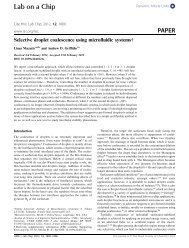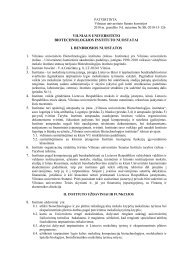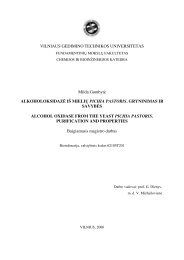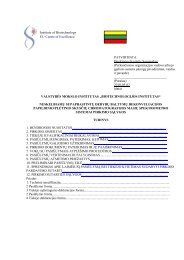Biennial Report 2011â2012
Biennial Report 2011â2012
Biennial Report 2011â2012
Create successful ePaper yourself
Turn your PDF publications into a flip-book with our unique Google optimized e-Paper software.
Department of Biothermodynamics and Drug Design<br />
Carbonic anhydrases as<br />
anticancer drug targets<br />
Carbonic anhydrases (CAs), a group of zinc containing enzymes,<br />
are involved in numerous physiological and pathological<br />
processes, including gluconeogenesis, lipogenesis, ureagenesis,<br />
tumorigenicity and the growth and virulence of various<br />
pathogens. In addition to the established role of CA inhibitors<br />
as diuretics and antiglaucoma drugs, it has recently<br />
emerged that CA inhibitors could have potential as novel<br />
anti-obesity, anticancer, and anti-infective drugs (Supuran,<br />
2008, 2012). CAs catalyze the conversion of CO 2<br />
to the bicarbonate<br />
ion and protons. There are 12 catalytically ac-<br />
tive CA isoenzymes in humans. A number of CA inhibitors,<br />
mostly unsubstituted sulfonamides, have already been designed.<br />
However, most present inhibitors are insufficiently selective<br />
for targeting CA isozymes, such as hCAIX and hCAX-<br />
II, which are anticancer targets.<br />
Here at the DBDD we have cloned and purified most cytoplasmic<br />
CAs and catalytic domains of transmembrane CAs.<br />
The organic synthesis team, together with collaborators, designed<br />
and synthesized over 500 novel compounds that bind<br />
CAs with submicromolar to subnanomolar affinity. Several<br />
novel series of CA inhibitors exhibited extremely tight affinity<br />
and an appreciable selectivity towards selected CA isozymes<br />
[1, 8].<br />
Figure 1. Additivity of the intrinsic thermodynamic parameters<br />
of compound binding to CA I (kJ/mol at 37 °C). Numbers at the<br />
compounds show the binding parameters while the numbers at the<br />
arrows show the differences. Averages of the differences are listed on the<br />
right and below the figure.<br />
58

















